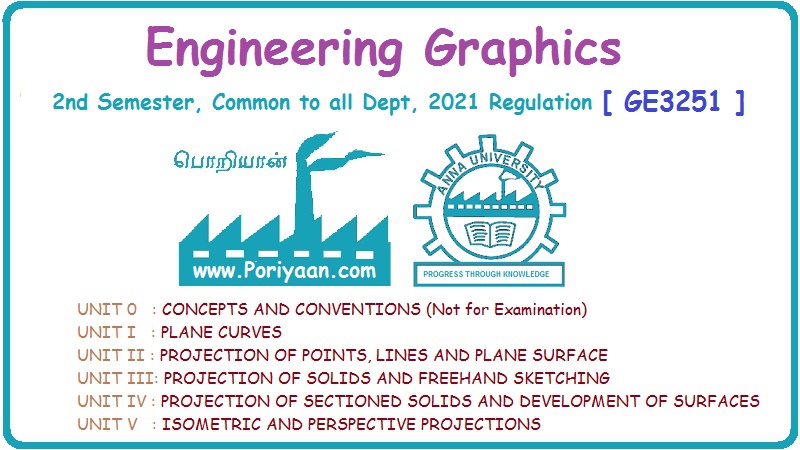Engineering Graphics: Unit IV (a): Sections of Solids
Sections of prisms
Construction, Steps, Example Problems | Engineering Graphics (EG)
Since the cutting plane is parallel to HP, section obtained in top view itself is the true shape of section.
SECTIONS OF PRISMS 1. Sections of Prisms by a Horizontal plane Example 6: A right regular pentagonal prism, side of base 30 mm and height 60 mm is lying on one of its rectangular faces upon HP, keeping the axis perpendicular to VP. A section plane parallel to HP cuts the solid at a height of 40 mm above the resting surface. Draw the front and sectional top views of the prism. Note: Since the cutting plane is parallel to HP, section obtained in top view itself is the true shape of section. Example 7: A triangular prism having a base with a 50 mm side and 80 mm long axis is lying on one of its rectangular faces in the HP with its axis perpendicular to VP. It is cut by a section plane parallel to and 20 mm above HP. Draw its front view and sectional top view. The pictorial view of the prism is shown in Fig. 15.17(i) and the projections are shown in Fig. 15.17(ii). 2. Section of Prism by a vertical plane Example 8: A Hexagonal prism having base with 35 mm side and 65 mm long is lying on its base in HP and one of the rectangular faces parallel to VP and axis perpendicular to HP. It is cut by a plane at 20 mm from the axis and towards the observer. Draw the top view and sectioned front view. The pictorial view of the prism is shown in Fig. 15.18 (i). Satisfying the given conditions. Projections of the prism after cut by the section plane are shown in Fig. 15.18(ii). 3. Sections of Prisms by planes inclined to HP and Perpendicular to VP Example 9: A square prism having a base with a 40 mm side and a 60 mm long axis rests on its base on HP such that one of the vertical faces makes an angle of 30° with VP. A section plane perpendicular to VP and inclined at 45° to HP, passing through the axis at a point 15 mm from its top end cuts the prism. Draw its front view, sectional top view and true shape of the section. The pictorial view of the square prism with the given conditions is shown in Fig. 15.19(i) and the projections with sections are shown in Fig. 15.19(ii). Step 1 (Top view): Draw a square of side 40 mm with an edge inclined at an angle 30° to XY line as the top view and name the corners. Step 2 (Front view): Project the corners and obtain the front view of the prism. Draw V. T of the cutting plane in the front view inclined at 45° to XY line and cut the axis at 15 mm from top edge. Let the cutting plane cut the edges 2(b)-3(c) and 3(c)-4(d) at 5 and 6 respectively. Project the points 5 and 6 to front view. Step 3 (Apparent section): Hatch the inner portion of the enclosed figure 1(a), 2(b), 5, 6, 4(d) and 1(a) which is the apparent shape of section. Step 4 (True section): Draw another axis X1Y1 parallel to cutting plane at convenient distance and project the points of intersection of cutting plane with the edges in front view, perpendicular to the cutting plane. Locate the points 11, 21 etc., on the projectors such that their distances from the X1Y1 line is equal to distances of 1, 2 etc., from the XY line respectively. Join the points 1121etc., in a sequence which represents the true shape of the section. Hatch the true section using thin lines inclined at 45°. Example 10: A Hexagonal prism of base side 30 mm and axis length 65 mm rests on one of its ends on HP with two rectangular faces parallel to VP. It is cut by a plane perpendicular to VP and inclined at 30° to HP. The cutting plane meets the axis at 30 mm from the top. Draw the front view, sectional top view and the true shape of the section. Pictorial view is shown in Fig. 15.20(i), resting on its base and two rectangular faces 2-3-C-B and 6-5-E-F) are parallel to VP. Cutting plane is inclined to HP meeting the axis at 30 mm from top. Projections with the sectional views are shown in Fig. 15.20(ii). Step 1 (Top view): Draw a hexagon as top view of side 30 mm, keeping two rectangular faces parallel to XY and name the corners by showing the hidden corners in the bracket. Step 2 (Front view): Project the top view and draw the front view using thin lines. The front view is a rectangle of height 65 mm (length of axis). Draw the V.T of cutting plane inclined at 30° to xy and cutting the axis at 30 mm from top. Project the points of intersection of cutting plane to the top view and hatch the area enclosed ie., the entire area which gives the apparent section. Step 3 (True section): Draw another axis X1Y1 at any convenient distance and parallel to XY. Project the points of intersection of cutting plane with the edges in front view perpendicular to the cutting plane. Locate the points 11, 21, 31 etc., such a way that the distances of these points from X1Y1 are equal to the distances of points 1, 2, 3 etc., respectively from XY. Join the points in proper sequence and hatch the area which gives the true shape of the section. Example 11: A Hexagonal prism of base side 40 mm and axis 55 mm long is resting on HP on one of its bases with two of the vertical faces perpendicular to VP. It is cut by a plane inclined at 60° to HP and perpendicular to VP, passing through a point at a distance 20 mm from the top base. Draw its front view, sectional top view and true shape of section. The pictorial view is shown in Fig. 15.21 (i) and the projections are shown in Fig. 15.21 (ii). The solution is self explanatory. 4. Sections of Prisms by planes inclined to VP and perpendicular to HP Example 12: A square prism having a base with 45 mm side and 70 mm long axis, rests on its base on HP such that one of its rectangular faces makes an angle of 30° with VP. It is cut by a section plane perpendicular to HP and inclined at 60° to VP such that the face which makes 60° with VP is bisected. Draw its sectional front view, top view and true shape of section. The pictorial view of the prism is shown in Fig. 15.22(i). Base is resting on HP, one of its rectangular faces is inclined at 30° to VP (ie., the edge 2-3), hence the other edge 1-2 is making an angle of 60° with VP. Cutting plane is bisecting the edge 1-2 at an angle of 60° with VP as shown in fig. The projections of the prism with the sections are shown in Fig. 15.22(ii). Step 1 (Top view): Draw a square as top view of side 45 mm, keeping one of the edges, inclined at 30° to XY and name the corners. Draw H.T of cutting plane at an angle of 60° to XY and bisecting the edges 1(a) - 2(b). Step 2 (Front View): Project the top view and draw the front view. Project the points of intersection of cutting plane with the edges of prism in top view (ie., 5(e) and 6(f)) using thicklines and hatch the surface enclosed by the lines using thin line at an angle of 45° which is the apparent shape of the section. Step 3 (True section): Draw another axis X1Y1 parallel to the cutting line at any convenient distance. Project 5(e) and 6(7), perpendicular to X1Y1. Locate the points 5'1, 6'1, e'1 and f'1 from X11 such that equal to the distances of points 5', 6', e', and f' respectively from XY. Join the points in sequence and hatch the surface. Example 13: A Hexagonal prism of base side 25 mm and height 50 mm rests on HP on one of its ends with two rectangular faces parallel to VP. It is cut by a plane perpendicular to HP and inclined at 60° to VP at a distance of 10 mm from the axis. Draw the top view, sectional front view and true shape of the section. Fig. 15.23(i) shows the pictorial view of the prism, base resting on HP and two rectangular faces parallel to VP (ie., the faces 2-3-C-B and 6-5-E-F are parallel to VP). Cutting plane is inclined at 60° to VP and 10 mm from the axis. The projections and the sectioned surfaces are shown in Fig. 15.23(ii).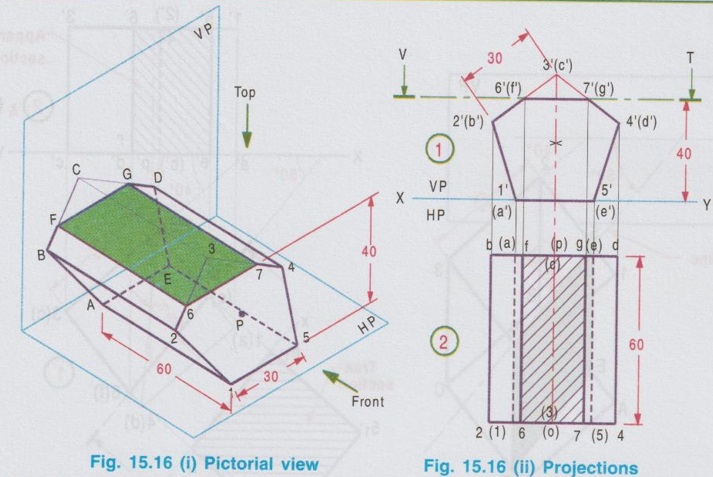 The pictorial view of pentagonal prism, one of its rectangular faces resting on HP is shown in Fig. 15.16(i). The projections of the prism with the sectioned surface are shown in Fig. 15.16(ii).
The pictorial view of pentagonal prism, one of its rectangular faces resting on HP is shown in Fig. 15.16(i). The projections of the prism with the sectioned surface are shown in Fig. 15.16(ii). 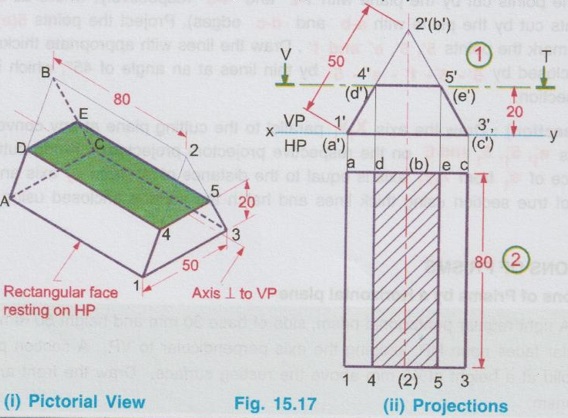
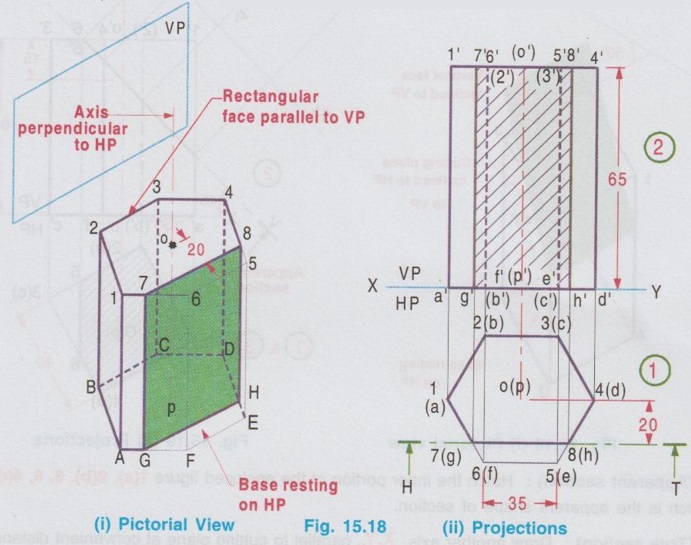
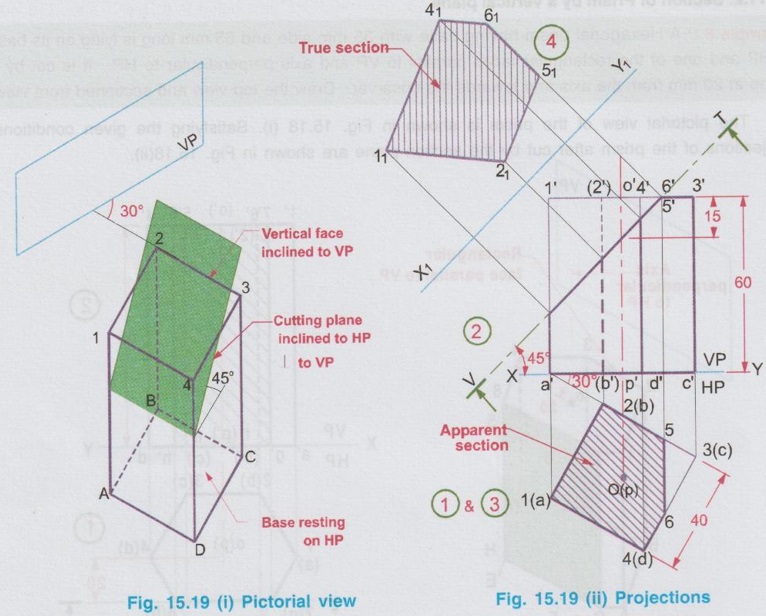
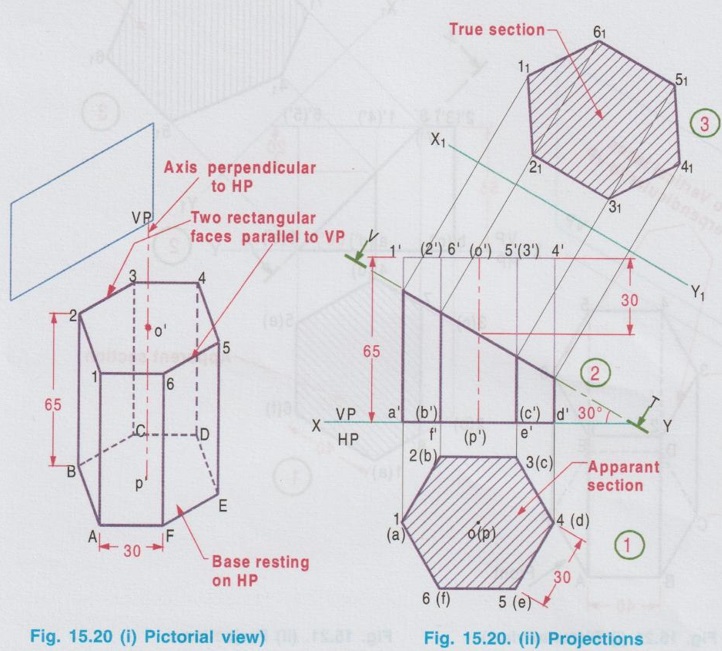
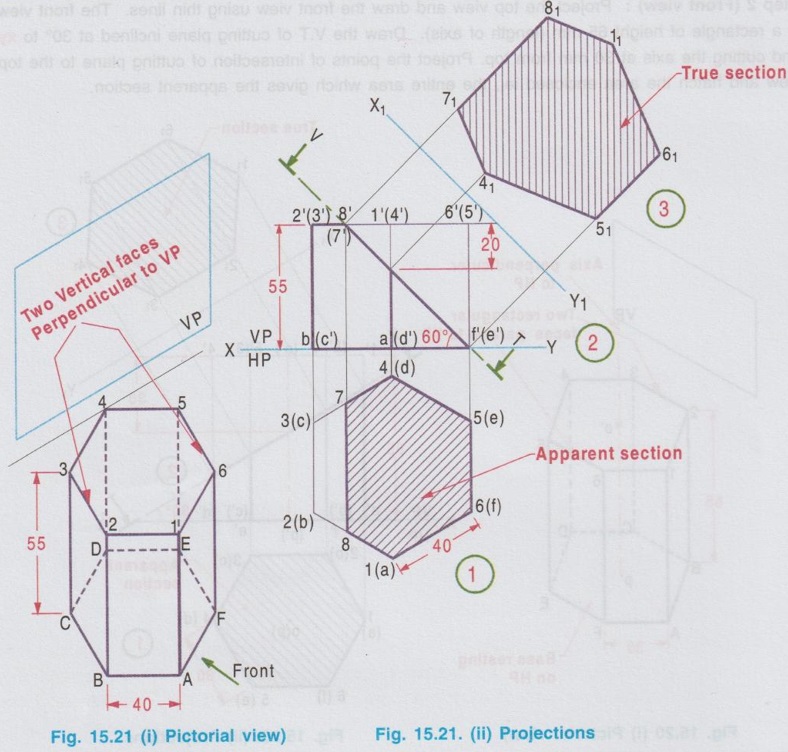
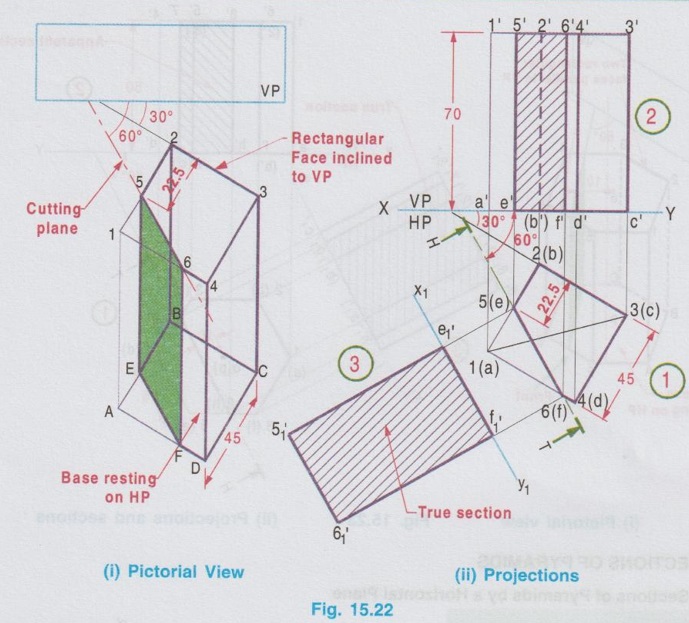
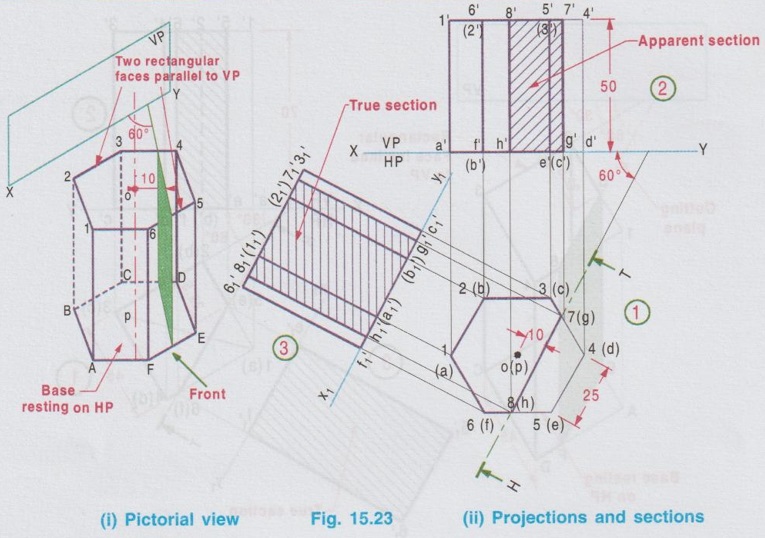
Engineering Graphics: Unit IV (a): Sections of Solids : Tag: : Construction, Steps, Example Problems | Engineering Graphics (EG) - Sections of prisms
Related Topics
Related Subjects
Engineering Graphics
GE3251 eg 2nd semester | 2021 Regulation | 2nd Semester Common to all Dept 2021 Regulation
